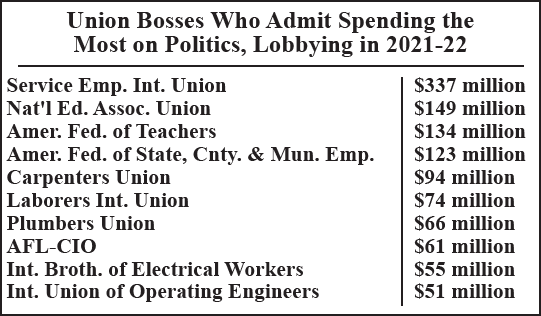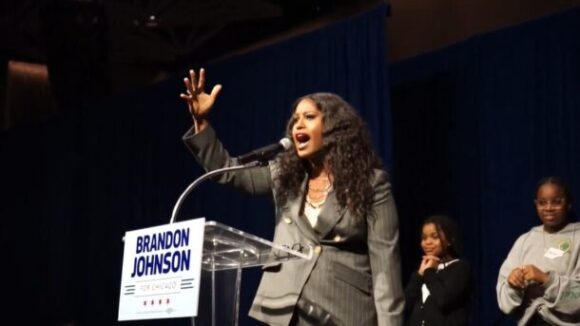Is This Any Way to Run a City’s Schools?
Leaked CTU Proposals Won’t Do Anything to Improve Schools’ Poor Performance

Just 6% of America’s private-sector wage and salary employees belong to a union.
Yet Big Labor is a, if not the, dominant force in American politics.
By their own admission, union officials who file LM-2 disclosure forms with the U.S. Labor Department (DOL) spent more than $1.6 billion on politics and lobbying during the 2021-22 election cycle.
That’s nearly $200 million more than what LM-2-filing union bosses admitted spending in 2019-20. And it’s far, far more than the grossly understated union political expenditures commonly cited by media outlets that arbitrarily include only spending reported to the Federal Election Commission (FEC).
But even the Big Labor political and lobbying expenditures reported on LM-2’s are far from comprehensive.
Most significantly, they leave out the vast sums of money Big Labor spends exercising its monopoly-bargaining power to codetermine with elected officials and/ or their appointees how millions of public servants are compensated and managed.
Management of the public workforce whose pay and benefits constitute roughly half of all state and local government spending is obviously a political matter, regardless of whether it is formally categorized as such.
When all the inherently political staffing, organizing, and messaging expenditures of government unions are factored in, the total amount of money Big Labor spends influencing public policy per federal campaign cycle likely exceeds $25 billion.
By comparison, union political action committees (PACs) collectively reported to the FEC a relatively paltry $54.7 million in expenditures during the 2021-22 election cycle.
So-called “mainstream” media reports on Big Labor political expenditures often focus solely on PAC donations, and if they address anything else they only touch on other expenditures reported to the FEC.
But it is obvious from LM-2-reported expenditures clearly categorized as “political activities and lobbying” that FEC measurements of what Big Labor spends on politics represent only the tip of the iceberg.
Staff members of the National Institute for Labor Relations Research, a research-only nonprofit affiliated with the National Right to Work Committee, recently added up all union expenditures recorded in “Schedule 16 – Political Activities and Lobbying” of LM-2’s filed for 2021 and 2022.
These data were accessed from the website of the DOL’s Office of Labor-Management Standards (OLMS)
In 2021 and 2022 combined, union officials collectively reported on their LM-2’s spending $1.62 billion on politics and lobbying.
Committee Vice President Greg Mourad noted:
“The OLMS doesn’t mention it, but the fact is that a very large share of funding for Schedule 16 ‘political activities and lobbying’ expenditures comes from union dues and fees collected from private-sector employees who would be fired for refusing to fork over any money.”
Schedule 16 activities are often underreported because union officials put clearly political expenses in other categories, including “contributions, gifts and grants” and “union administration.”
A recently-published analysis by the Institute furnishes a number of specific examples.
A separate reason Schedule 16 aggregates understate union political spending is that many deeply political unions don’t have to file LM-2’s because they have no private-sector members at all and/or they have annual revenues below $250,000.
But the fundamental way Schedule 16 understates union political spending is definitional.
As the U.S. Supreme Court affirmed in its 2018 Janus decision, a case argued and won by a National Right to Work Legal Defense Foundation staff attorney, public sector union monopoly bargaining and politics are inseparable.
In his Janus majority opinion, Associate Justice Sam Alito explained that union speech directed at public employers “is overwhelmingly of substantial public concern,” and not only because it affects “how public money is spent.”
Through union monopoly bargaining, union officials “express views on a wide range” of public issues, including “education, child welfare, healthcare,” and minority rights.
There was nothing novel about the Janus court’s assessment.
Indeed, nearly two decades before this decision came down, then National Education Association (NEA) union General Counsel Robert Chanin acknowledged to a reporter for Education Week that government-sector union monopoly bargaining and politics are indissolubly wed:
“So you tell me how I can possibly separate NEA’s collective bargaining efforts from politics — you just can’t. It’s all politics.”
What share of all union expenditures are government union expenditures? Since quite a few government unions don’t have to file LM-2’s, this isn’t an easy question to answer precisely. But the answer seems to be: roughly half.

Mr. Mourad explained:
“According to the DOL’s Bureau of Labor Statistics, there were 7.1 million private-sector and 7.2 million public-sector union members in the U.S. last year.
“That means that, since LM-2-filing unions combined disbursed $50 billion in 2021 and 2022, it is reasonable to assume that all government union expenditures plus Schedule 16 private-sector union expenditures for those two years equal over $25 billion.
“The Institute puts it at $25.6 billion. As the Institute acknowledges, this assumes public- and private-sector unions spend the same amount per coerced ‘member.’ If one type of union spends more per employee than the other, the estimate could be off in either direction.
“But questions about the exact magnitude of Big Labor political spending don’t affect the fundamental issues here.
“Big Labor is a vast political machine that many workers must fund in order to keep their jobs.
“Forced dues-fueled union political spending pays for phone banks, get-out-the-vote drives, propaganda mailings, and other ‘in-kind’ support for Big Labor’s favored candidates. And union treasury money is used lavishly to lobby for bigger government and higher taxes.
“Fortunately, civil servants in all 50 states now have Right to Work protections, thanks to Janus, and private-sector employees in the 27 states that currently have Right to Work laws are also protected from being forced to bankroll Big Labor’s favored causes and candidates.
“But it remains Congress’s obligation to crack down on forced-dues politicking and protect the free-speech rights of employees across the nation.
“This objective can be accomplished through passage of the National Right to Work Act [H.R.1200/S.532], legislation that would repeal the handful of provisions in federal labor law under which millions of employees are still being forced to bankroll unions.”
This article was originally published in our monthly newsletter. Go here to access previous newsletter posts.
To support our cause and help end forced unionism, go here to donate.

Leaked CTU Proposals Won’t Do Anything to Improve Schools’ Poor Performance

Wherever Big Labor wields the power to collect forced union dues, union bosses funnel a large share of the confiscated money into efforts to elect and reelect business-bashing politicians. Employment growth tends to lag as a consequence.

Members Insist They Keep Pro-Right to Work Campaign Promises